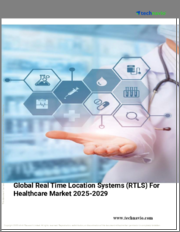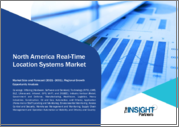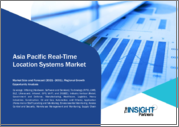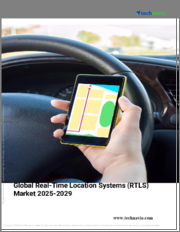
|
시장보고서
상품코드
1675404
헬스케어용 실시간 위치추적 시스템(RTLS) 시장 : 제공별, 애플리케이션별, 최종 용도별, 지역별(2025-2033년)Real Time Location Systems for Healthcare Market by Offering, Applications, End Use, and Region 2025-2033 |
||||||
세계의 헬스케어용 RTLS(실시간 위치추적 시스템) 시장 규모는 2024년에 30억 달러에 달했습니다. 향후 IMARC Group은 시장이 2033년까지 116억 달러에 달하며, 2025-2033년의 성장률(CAGR)은 15.34%에 달할 것으로 예측하고 있습니다. 자산 추적·관리 요구의 증가, 원격 환자 모니터링 수요의 증가, 다양한 기술 진보가 시장을 촉진하는 주요 요인의 일부입니다.
RTLS는 자산이나 사람, 사물의 위치를 실시간으로 자동으로 식별하고 추적하기 위한 일련의 기술입니다. RFID(Radio Frequency Identification), Wi-Fi(Wireless Fidelity), Bluetooth low energy, GPS(Global Positioning System), 초음파 등의 무선통신 기술을 이용하여 자산 및 개인의 위치를 추적·식별합니다. 헬스케어 업계에서는 환자의 안전성, 스탭 효율성, 자산관리의 개선에 이용되고 있습니다. 또한 의료 장비 추적, 환자의 움직임 모니터링, 직원이 적절한 위생 프로토콜을 준수하고 있는지 확인하는데도 활용되고 있습니다. 또한 워크플로우 최적화, 효율성 향상, 대기 시간 단축, 환자 만족도 향상에도 활용되고 있습니다. 이 외에도 이러한 시스템을 통해 수집된 데이터는 병목현상 파악, 자원 배분 최적화, 전반적인 업무 효율성 개선 등의 분석에 활용될 수 있습니다. 이러한 장점으로 인해 RTLS 시스템은 전 세계 헬스케어 업계에서 널리 사용되고 있습니다.
헬스케어용 RTLS 시장 동향 :
이 시장의 주요 원동력은 자산 추적 및 관리에 대한 수요 증가입니다. 의료 기관은 의료기기, 의약품, 소모품을 관리하기 위해 RTLS를 채택하고 있으며, RTLS는 자산의 위치와 상태에 대한 실시간 정보를 제공하여 재고 관리를 개선하고 장비의 손실을 줄일 수 있습니다. 또한 환자 안전에 대한 관심이 높아지면서 RTLS는 환자의 위치 및 이동에 대한 실시간 정보를 제공하여 부작용의 위험을 줄이고 응급상황에 대한 대응 시간을 개선함으로써 환자 안전을 향상시킬 수 있습니다. 이 외에도 헬스케어용 IoT 통합을 통한 환자 및 자산의 실시간 위치 정보 제공 등 다양한 기술 발전도 시장 성장에 기여하고 있습니다. 또한 여러 정부 기관은 의료 기관이 환자 및 장비의 이동에 대한 정확한 기록을 유지하도록 하는 정책을 시행하고 있으며, RTLS는 실시간 위치 데이터를 제공함으로써 의료 시설이 이러한 요구 사항을 준수하는 데 도움이 될 수 있습니다. 이는 코로나바이러스 감염증(COVID-19)의 갑작스러운 대유행으로 인한 원격 환자 모니터링에 대한 수요 증가와 맞물려 제품 도입 속도를 가속화하고 있습니다. 또한 의료 인프라의 발전과 의료비 증가는 전 세계에서 좋은 시장 전망을 창출하고 있습니다.
이 보고서에서 다룬 주요 질문
- 세계 헬스케어용 RTLS 시장은 지금까지 어떻게 추이해 왔는가?
- 세계 헬스케어용 RTLS 시장의 성장 촉진요인, 저해요인, 기회요인은 무엇인가?
- 각 촉진요인, 억제요인, 기회가 세계의 헬스케어용 RTLS 시장에 미치는 영향은 무엇인가?
- 주요 지역 시장은?
- 헬스케어용 RTLS 시장에서 가장 매력적인 국가는?
- 제공별 시장 분석은?
- 의료용 RTLS 시장에서 가장 매력적인 제공 제품은 무엇인가?
- 용도별 시장 분석은?
- 헬스케어용 RTLS 시장에서 가장 매력적인 용도는 무엇인가?
- 최종사용자별 시장 분석은?
- 헬스케어용 RTLS 시장에서 가장 매력적인 최종사용자는?
- 세계 헬스케어용 RTLS 시장의 경쟁 구도는?
- 세계 헬스케어용 RTLS 시장의 주요 기업은?
목차
제1장 서문
제2장 조사 범위와 조사 방법
- 조사의 목적
- 이해관계자
- 데이터 소스
- 1차 정보
- 2차 정보
- 시장 추정
- 보텀업 어프로치
- 톱다운 어프로치
- 조사 방법
제3장 개요
제4장 서론
- 개요
- 주요 업계 동향
제5장 세계의 헬스케어용 RTLS 시장
- 시장 개요
- 시장 실적
- COVID-19의 영향
- 시장 예측
제6장 시장 내역 : 제공별
- 소프트웨어
- 하드웨어
- 서비스
제7장 시장 내역 : 애플리케이션별
- 자산 추적
- 환자 안전성
- 인사 추적
- 환경 모니터링
- 기타
제8장 시장 내역 : 최종 용도별
- 병원
- 클리닉
- 응급의료 서비스
- 고령자 요양시설
- 진단 실험실
제9장 시장 내역 : 지역별
- 북미
- 미국
- 캐나다
- 아시아태평양
- 중국
- 일본
- 인도
- 한국
- 호주
- 인도네시아
- 기타
- 유럽
- 독일
- 프랑스
- 영국
- 이탈리아
- 스페인
- 러시아
- 기타
- 라틴아메리카
- 브라질
- 멕시코
- 기타
- 중동 및 아프리카
- 시장 내역 : 국가별
제10장 촉진요인·억제요인·기회
- 개요
- 촉진요인
- 억제요인
- 기회
제11장 밸류체인 분석
제12장 Porter's Five Forces 분석
- 개요
- 바이어의 교섭력
- 공급 기업의 교섭력
- 경쟁의 정도
- 신규 진출업체의 위협
- 대체품의 위협
제13장 가격 분석
제14장 경쟁 구도
- 시장 구조
- 주요 기업
- 주요 기업의 개요
- AiRISTA Flow Inc.
- Centrak Inc.(Halma plc)
- GE Healthcare Technologies Inc.(General Electric Company)
- Hewlett Packard Enterprise Development LP
- Midmark Corporation
- Sonitor Technologies AS
- Stanley Healthcare(Stanley Black & Decker Inc.)
- TeleTracking Technologies Inc.
- Zebra Technologies Corporation
The global real time location systems (RTLS) for healthcare market size reached USD 3.0 Billion in 2024. Looking forward, IMARC Group expects the market to reach USD 11.6 Billion by 2033, exhibiting a growth rate (CAGR) of 15.34% during 2025-2033. The rising need for asset tracking and management, the increasing demand for remote patient monitoring, and various technological advancements represent some of the key factors driving the market.
Real-time location systems (RTLS) are a set of technologies used to automatically identify and track the location of assets, people or objects in real time. They use wireless communication technologies such as radio frequency identification (RFID), Wireless Fidelity (Wi-Fi), Bluetooth low energy, global positioning system (GPS), and ultrasound to track and locate assets or individuals. It is used in the healthcare industry to improve patient safety, staff efficiency, and asset management. It is also utilized to track medical equipment, monitor patient movements, and ensure that staff members are adhering to proper hygiene protocols. In addition, it is used to optimize workflows, increase efficiency, reduce wait times, and enhance patient satisfaction. Besides this, the data collected by these systems can also be used for analytics, such as identifying bottlenecks, optimizing resource allocation, and improving overall operational efficiency. Owing to these benefits, RTLS systems are widely adopted in the healthcare industry across the globe.
Real Time Location Systems (RTLS) for Healthcare Market Trends:
The market is primarily driven by the increasing need for asset tracking and management. Healthcare organizations are adopting solutions to manage medical equipment, drugs, and supplies. RTLS can provide real-time information on the location and status of assets, improving inventory control and reducing equipment loss. In addition, the growing focus on patient safety represents another major growth-inducing factor. RTLS can improve patient safety by providing real-time information on patient location and movement, reducing the risk of adverse events, and improving response times in emergencies. Besides this, various technological advancements, such as the integration of The Internet of Things (IoT) in healthcare to provide real-time location data for patients and assets, are also contributing to the market growth. Moreover, various government agencies are implementing policies mandating healthcare institutes to maintain accurate records of patient and equipment movements. RTLS can help healthcare facilities comply with these requirements by providing real-time location data. This, coupled with the increasing demand for remote patient monitoring due to the sudden outbreak of the coronavirus disease (COVID-19) pandemic, is accelerating the product adoption rate. Furthermore, the developing healthcare infrastructure and rising healthcare expenditure are also creating a favorable market outlook across the globe.
Key Market Segmentation:
Offering Insights:
- Software
- Hardware
- Service
Applications Insights:
- Asset Tracking
- Patient Safety
- Personnel Tracking
- Environmental Monitoring
- Others
End Use Insights:
- Hospitals
- Clinics
- Emergency Medical Services
- Eldercare Facilities
- Diagnostic Labs
Regional Insights:
- North America
- United States
- Canada
- Europe
- Germany
- France
- United Kingdom
- Italy
- Spain
- Russia
- Others
- Asia Pacific
- China
- Japan
- India
- South Korea
- Australia
- Indonesia
- Others
- Latin America
- Brazil
- Mexico
- Others
- Middle East and Africa
- The report has also provided a comprehensive analysis of all the major regional markets, which include North America (the United States and Canada); Europe (Germany, France, the United Kingdom, Italy, Spain, Russia, and others); Asia Pacific (China, Japan, India, South Korea, Australia, Indonesia, and others); Latin America (Brazil, Mexico, and others); and the Middle East and Africa. According to the report, Asia Pacific was the largest market for real time location systems (RTLS) for healthcare. Some of the factors driving the Asia Pacific real time location systems (RTLS) for healthcare market included the growing preference for better patient care, the rising need for asset management, the implementation of government initiatives, etc.
Competitive Landscape:
- The report has also provided a comprehensive analysis of the competitive landscape in the global real time location systems (RTLS) for healthcare market. Competitive analysis such as market structure, market share by key players, player positioning, top winning strategies, competitive dashboard, and company evaluation quadrant has been covered in the report. Also, detailed profiles of all major companies have been provided. Some of the companies covered include AiRISTA Flow Inc., Centrak Inc. (Halma plc), GE Healthcare Technologies Inc. (General Electric Company), Hewlett Packard Enterprise Development LP, Midmark Corporation, Sonitor Technologies AS, Stanley Healthcare (Stanley Black & Decker Inc.), TeleTracking Technologies Inc., Zebra Technologies Corporation, etc.
Key Questions Answered in This Report:
- How has the global real time location systems (RTLS) for healthcare market performed so far, and how will it perform in the coming years ?
- What are the drivers, restraints, and opportunities in the global real time location systems (RTLS) for healthcare market ?
- What is the impact of each driver, restraint, and opportunity on the global real time location systems (RTLS) for healthcare market ?
- What are the key regional markets ?
- Which countries represent the most attractive real time location systems (RTLS) for healthcare market ?
- What is the breakup of the market based on the offering ?
- Which is the most attractive offering in the real time location systems (RTLS) for healthcare market ?
- What is the breakup of the market based on the application ?
- Which is the most attractive application in the real time location systems (RTLS) for healthcare market ?
- What is the breakup of the market based on the end user ?
- Which is the most attractive end user in the real time location systems (RTLS) for healthcare market ?
- What is the competitive structure of the global real time location systems (RTLS) for healthcare market ?
- Who are the key players/companies in the global real time location systems (RTLS) for healthcare market ?
Table of Contents
1 Preface
2 Scope and Methodology
- 2.1 Objectives of the Study
- 2.2 Stakeholders
- 2.3 Data Sources
- 2.3.1 Primary Sources
- 2.3.2 Secondary Sources
- 2.4 Market Estimation
- 2.4.1 Bottom-Up Approach
- 2.4.2 Top-Down Approach
- 2.5 Forecasting Methodology
3 Executive Summary
4 Introduction
- 4.1 Overview
- 4.2 Key Industry Trends
5 Global Real Time Location Systems (RTLS) for Healthcare Market
- 5.1 Market Overview
- 5.2 Market Performance
- 5.3 Impact of COVID-19
- 5.4 Market Forecast
6 Market Breakup by Offering
- 6.1 Software
- 6.1.1 Market Trends
- 6.1.2 Market Forecast
- 6.2 Hardware
- 6.2.1 Market Trends
- 6.2.2 Market Forecast
- 6.3 Service
- 6.3.1 Market Trends
- 6.3.2 Market Forecast
7 Market Breakup by Application
- 7.1 Asset Tracking
- 7.1.1 Market Trends
- 7.1.2 Market Forecast
- 7.2 Patient Safety
- 7.2.1 Market Trends
- 7.2.2 Market Forecast
- 7.3 Personnel Tracking
- 7.3.1 Market Trends
- 7.3.2 Market Forecast
- 7.4 Environmental Monitoring
- 7.4.1 Market Trends
- 7.4.2 Market Forecast
- 7.5 Others
- 7.5.1 Market Trends
- 7.5.2 Market Forecast
8 Market Breakup by End Use
- 8.1 Hospitals
- 8.1.1 Market Trends
- 8.1.2 Market Forecast
- 8.2 Clinics
- 8.2.1 Market Trends
- 8.2.2 Market Forecast
- 8.3 Emergency Medical Services
- 8.3.1 Market Trends
- 8.3.2 Market Forecast
- 8.4 Eldercare Facilities
- 8.4.1 Market Trends
- 8.4.2 Market Forecast
- 8.5 Diagnostic Labs
- 8.5.1 Market Trends
- 8.5.2 Market Forecast
9 Market Breakup by Region
- 9.1 North America
- 9.1.1 United States
- 9.1.1.1 Market Trends
- 9.1.1.2 Market Forecast
- 9.1.2 Canada
- 9.1.2.1 Market Trends
- 9.1.2.2 Market Forecast
- 9.1.1 United States
- 9.2 Asia-Pacific
- 9.2.1 China
- 9.2.1.1 Market Trends
- 9.2.1.2 Market Forecast
- 9.2.2 Japan
- 9.2.2.1 Market Trends
- 9.2.2.2 Market Forecast
- 9.2.3 India
- 9.2.3.1 Market Trends
- 9.2.3.2 Market Forecast
- 9.2.4 South Korea
- 9.2.4.1 Market Trends
- 9.2.4.2 Market Forecast
- 9.2.5 Australia
- 9.2.5.1 Market Trends
- 9.2.5.2 Market Forecast
- 9.2.6 Indonesia
- 9.2.6.1 Market Trends
- 9.2.6.2 Market Forecast
- 9.2.7 Others
- 9.2.7.1 Market Trends
- 9.2.7.2 Market Forecast
- 9.2.1 China
- 9.3 Europe
- 9.3.1 Germany
- 9.3.1.1 Market Trends
- 9.3.1.2 Market Forecast
- 9.3.2 France
- 9.3.2.1 Market Trends
- 9.3.2.2 Market Forecast
- 9.3.3 United Kingdom
- 9.3.3.1 Market Trends
- 9.3.3.2 Market Forecast
- 9.3.4 Italy
- 9.3.4.1 Market Trends
- 9.3.4.2 Market Forecast
- 9.3.5 Spain
- 9.3.5.1 Market Trends
- 9.3.5.2 Market Forecast
- 9.3.6 Russia
- 9.3.6.1 Market Trends
- 9.3.6.2 Market Forecast
- 9.3.7 Others
- 9.3.7.1 Market Trends
- 9.3.7.2 Market Forecast
- 9.3.1 Germany
- 9.4 Latin America
- 9.4.1 Brazil
- 9.4.1.1 Market Trends
- 9.4.1.2 Market Forecast
- 9.4.2 Mexico
- 9.4.2.1 Market Trends
- 9.4.2.2 Market Forecast
- 9.4.3 Others
- 9.4.3.1 Market Trends
- 9.4.3.2 Market Forecast
- 9.4.1 Brazil
- 9.5 Middle East and Africa
- 9.5.1 Market Trends
- 9.5.2 Market Breakup by Country
- 9.5.3 Market Forecast
10 Drivers, Restraints, and Opportunities
- 10.1 Overview
- 10.2 Drivers
- 10.3 Restraints
- 10.4 Opportunities
11 Value Chain Analysis
12 Porters Five Forces Analysis
- 12.1 Overview
- 12.2 Bargaining Power of Buyers
- 12.3 Bargaining Power of Suppliers
- 12.4 Degree of Competition
- 12.5 Threat of New Entrants
- 12.6 Threat of Substitutes
13 Price Analysis
14 Competitive Landscape
- 14.1 Market Structure
- 14.2 Key Players
- 14.3 Profiles of Key Players
- 14.3.1 AiRISTA Flow Inc.
- 14.3.1.1 Company Overview
- 14.3.1.2 Product Portfolio
- 14.3.2 Centrak Inc. (Halma plc)
- 14.3.2.1 Company Overview
- 14.3.2.2 Product Portfolio
- 14.3.3 GE Healthcare Technologies Inc. (General Electric Company)
- 14.3.3.1 Company Overview
- 14.3.3.2 Product Portfolio
- 14.3.4 Hewlett Packard Enterprise Development LP
- 14.3.4.1 Company Overview
- 14.3.4.2 Product Portfolio
- 14.3.4.3 Financials
- 14.3.4.4 SWOT Analysis
- 14.3.5 Midmark Corporation
- 14.3.5.1 Company Overview
- 14.3.5.2 Product Portfolio
- 14.3.6 Sonitor Technologies AS
- 14.3.6.1 Company Overview
- 14.3.6.2 Product Portfolio
- 14.3.7 Stanley Healthcare (Stanley Black & Decker Inc.)
- 14.3.7.1 Company Overview
- 14.3.7.2 Product Portfolio
- 14.3.8 TeleTracking Technologies Inc.
- 14.3.8.1 Company Overview
- 14.3.8.2 Product Portfolio
- 14.3.9 Zebra Technologies Corporation
- 14.3.9.1 Company Overview
- 14.3.9.2 Product Portfolio
- 14.3.9.3 Financials
- 14.3.9.4 SWOT Analysis
- 14.3.1 AiRISTA Flow Inc.
Kindly note that this only represents a partial list of companies, and the complete list has been provided in the report.



















